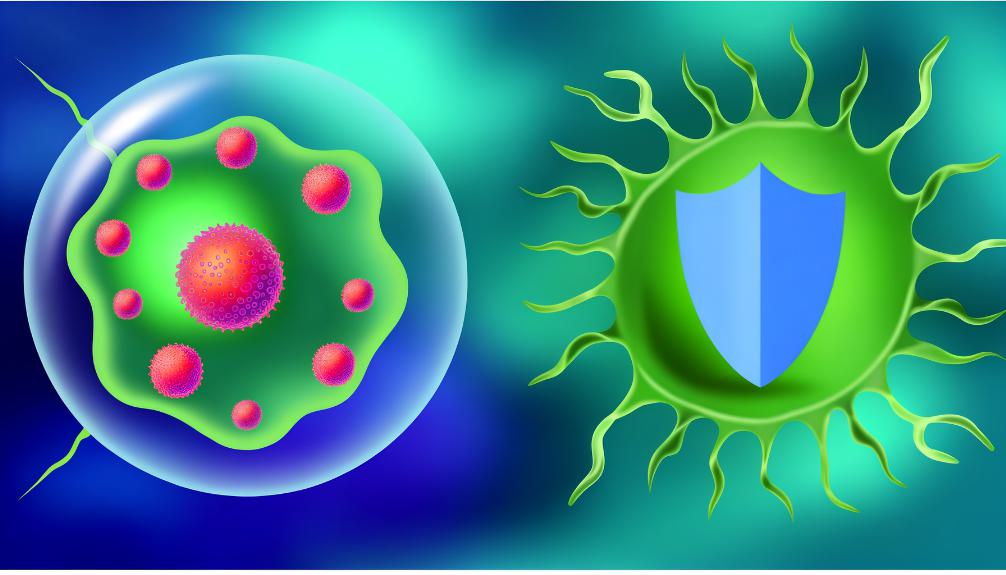
Navigating the nuances of NRF2 activation, you'll discover its dynamic defense against oxidative stress. This cellular pathway plays a pivotal role in enhancing your body's antioxidant capacity, reducing inflammation, and fortifying your immune system. By elevating endogenous antioxidant levels, NRF2 activation not only shields cells from oxidative damage but also potentially slows the aging process.
Evidence-based research underscores its significance in strengthening cellular defense mechanisms, making it a cornerstone in the quest for longevity and health optimization. Unraveling the full spectrum of benefits tied to NRF2 activation could unlock new avenues for preventive health strategies, inviting further exploration into its therapeutic potential.
Enhancing Cellular Defense
Activation of NRF2 plays a crucial role in enhancing cellular defense mechanisms against oxidative stress by upregulating the expression of antioxidant genes. When you're exposed to environmental toxins, your body's cells face oxidative stress, a precarious state where harmful free radicals outnumber antioxidants. This imbalance can damage cells, proteins, and even your DNA, leading to a myriad of health issues. However, NRF2 serves as a master regulator of antioxidant response, orchestrating the production of protective enzymes such as superoxide dismutase, catalase, and glutathione peroxidase.
These enzymes work tirelessly to neutralize free radicals, reducing oxidative damage and bolstering cellular resilience. By activating NRF2, you're essentially boosting your body's own defense system, creating a more robust shield against environmental insults. Moreover, research has shown that enhanced NRF2 activity can prolong cell survival under stress conditions, supporting cellular repair processes and maintaining cellular integrity.
Understanding the importance of NRF2 in defending against oxidative stress underscores the value of strategies aimed at activating this pathway. Through dietary choices, lifestyle changes, and potentially pharmacological interventions, you can effectively enhance your cellular defenses, providing a solid foundation for long-term health and well-being.
Reducing Inflammation
Beyond enhancing cellular defenses against oxidative stress, activating NRF2 also plays a pivotal role in mitigating inflammation throughout the body. Inflammation, while a natural response to injury or infection, can become chronic and contribute to a range of diseases, including arthritis, heart disease, and diabetes. NRF2's ability to reduce inflammation is a critical aspect of its protective effects.
Research has shown that NRF2 activation modulates the production of inflammatory cytokines, which are signaling molecules that mediate and regulate immunity, inflammation, and hematopoiesis. By reducing the expression of these cytokines, NRF2 helps to dampen the inflammatory response. Additionally, it inhibits the activation of NF-kB, a protein complex that plays a significant role in controlling the transcription of DNA, cytokine production, and cell survival. NF-kB is known to be a key player in the inflammatory process.
Thus, activating NRF2 not only shields cells from oxidative damage but also significantly lowers inflammation levels. This dual action makes NRF2 a valuable target for therapeutic strategies aimed at reducing oxidative stress and inflammation-related diseases. By understanding and leveraging the benefits of NRF2 activation, you're better equipped to manage inflammation and enhance your overall health.
Elevating Antioxidant Levels
Elevating your body's antioxidant levels through NRF2 activation crucially enhances its defense against cellular damage caused by free radicals. This process is central to mitigating oxidative stress, a condition linked with various chronic diseases. NRF2, a transcription factor, plays a pivotal role in upregulating the expression of antioxidant proteins that neutralize harmful free radicals.
When activated, NRF2 moves into the cell nucleus and binds to the Antioxidant Response Element (ARE) in the DNA, initiating the transcription of genes responsible for producing antioxidants such as glutathione, superoxide dismutase (SOD), and catalase. These antioxidants are crucial for maintaining cellular health and function.
Research demonstrates that an increase in NRF2 activity can significantly boost the body's intrinsic antioxidant levels, offering a robust defense mechanism against oxidative damage. For instance, glutathione, often referred to as the 'master antioxidant,' is vital for detoxifying harmful compounds. By enhancing NRF2 activation, your body's capacity to synthesize glutathione is markedly improved, leading to improved resilience against oxidative stress.
This mechanism underscores the importance of NRF2 in cellular protection and the maintenance of homeostasis amidst environmental and metabolic challenges.
Slowing Aging Processes
Understanding the role of NRF2 activation in bolstering antioxidant levels leads us to its potential impact on decelerating the aging process. The aging process is inherently linked to the accumulation of oxidative damage in cells, contributing to the decline in physiological functions and the onset of age-related diseases. NRF2, a transcription factor, plays a pivotal role in activating the expression of antioxidant proteins that protect against oxidative damage triggered by free radicals and electrophiles.
Research has demonstrated that activating NRF2 not only enhances the body's antioxidant defenses but also mitigates the detrimental effects of oxidative stress on cellular components, thereby slowing the aging process at the molecular level. This deceleration is evidenced by the preservation of telomere length, reduction in cellular senescence, and maintenance of protein homeostasis, crucial factors in extending cellular lifespan and enhancing organ function.
Moreover, NRF2 activation has been shown to modulate the expression of genes involved in detoxification processes, further protecting cells from oxidative damage and supporting longevity. This comprehensive protection mechanism underscores the significance of NRF2 in counteracting the biological mechanisms underlying aging, offering a promising avenue for interventions aimed at extending healthspan.
Strengthening Immune Function
NRF2 activation not only combats oxidative stress but also plays a crucial role in strengthening your immune function by enhancing the body's defense mechanisms against pathogens. This pivotal transcription factor orchestrates the upregulation of antioxidant proteins, which neutralize free radicals and reduce oxidative damage. By doing so, it indirectly supports the immune system, ensuring that cells remain healthy and fully functional in their role as defenders against infections and diseases.
Research has demonstrated that NRF2's ability to modulate immune responses goes beyond just antioxidative actions. It influences the expression of cytokines, molecules vital for cell signaling in the immune system, promoting an environment conducive to immune resilience. This means you're better equipped to ward off illnesses and recover more swiftly when you do fall sick.
Furthermore, NRF2 has been shown to enhance the function of both innate and adaptive immunity. It supports the activities of macrophages, a type of white blood cell that engulfs and digests cellular debris and pathogens, and helps in the differentiation of T-cells, crucial for the body's adaptive immunity. Thus, activating NRF2 not only shields your cells from oxidative stress but significantly bolsters your immune system's capacity to fight off invaders, keeping you healthier in the long run.
Frequently Asked Questions
How Does NRF2 Activation Specifically Impact Chronic Diseases Beyond Its Role in Oxidative Stress Management?
NRF2 activation plays a crucial role beyond just managing oxidative stress; it significantly impacts chronic diseases. By promoting the expression of antioxidant proteins, it helps protect cells from damage.
This mechanism is vital in preventing and mitigating conditions like cancer, neurodegenerative diseases, and cardiovascular issues.
You'll find that activating NRF2 can improve your body's resilience against these diseases, offering a strategic defense by enhancing cellular health and function.
Can NRF2 Activation Interfere With or Enhance the Effectiveness of Certain Medications or Treatments for Other Conditions?
You're diving into how NRF2 activation might impact medications or other treatments. It's crucial to understand that NRF2's role isn't isolated; it can interact with drugs by altering their effectiveness or side effects.
For instance, if NRF2 enhances the detoxifying pathways in your cells, it could potentially reduce the effectiveness of certain drugs. Conversely, it might protect against drug-induced oxidative damage, possibly enhancing treatment outcomes.
Always consult healthcare professionals when considering these interactions.
Are There Any Known Negative Side Effects or Risks Associated With Artificially Inducing NRF2 Activation Through Supplements or Drugs?
You're considering artificially inducing NRF2 activation through supplements or drugs. It's crucial to be aware that, while promising, this approach isn't without risks. Potential side effects can include interactions with medications, impacting their effectiveness, or unforeseen impacts on other conditions.
It's essential to consult healthcare professionals before starting any new supplement or drug regimen aimed at NRF2 activation to navigate these risks safely and effectively.
How Does an Individual's Diet and Lifestyle Affect NRF2 Activation and Its Potential Benefits Outside the Direct Mechanisms of Enhancing Cellular Defense and Reducing Inflammation?
Your diet and lifestyle significantly influence NRF2 activation, beyond just bolstering cellular defense and tempering inflammation.
Consuming antioxidant-rich foods like berries, nuts, and leafy greens can naturally enhance NRF2 pathways. Similarly, engaging in regular physical activity and avoiding smoking or excessive alcohol intake can optimize NRF2's beneficial effects.
These habits not only activate NRF2 but also support overall health by mitigating oxidative stress and reducing the risk of chronic diseases.
Is There a Difference in the Efficacy of NRF2 Activation Between Different Age Groups or Populations With Specific Genetic Backgrounds?
Yes, there's a difference in NRF2 activation efficacy among age groups and genetic backgrounds. Studies show younger individuals may experience more robust activation, enhancing their cellular defense mechanisms against oxidative stress.
Conversely, older adults or those with certain genetic predispositions might see diminished responses. This variability underlines the importance of personalized approaches in leveraging NRF2 activation for health benefits, tailoring interventions to individual genetic and demographic profiles for optimum outcomes.
Conclusion
By activating NRF2, you're directly enhancing your body's cellular defenses against oxidative stress. This not only reduces inflammation and boosts antioxidant levels but also plays a crucial role in slowing down the aging process.
Moreover, NRF2 activation significantly strengthens immune function, providing a robust shield against various diseases and health issues. Embracing strategies that promote NRF2 activity can, therefore, offer a comprehensive approach to maintaining optimal health and well-being, backed by a wealth of scientific evidence.
Please validate any information here with a healthcare professional. The content is provided for education purposes, This content has not been evaluated by the Food and Drug Administration. Any advice or products mentioned is/are not intended to diagnose, treat, cure, or prevent any disease,










